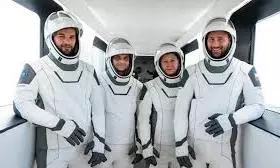
A success story in the blue sky
text_fieldsThe launch of the Axiom-4 spacecraft from the Kennedy Space Center in Florida at 12:01 pm Indian time on Wednesday was a historic moment. One of the key factors that makes this mission so popular among the global science community is that it is the fourth successful mission of Axiom Space, a private space exploration company launched just nine years ago. Some see it as a signpost for future space exploration in a new era when private research institutions are gaining the upper hand. This is a huge leap and a proud moment for India. It also represents the end of a four-decade wait. Rakesh Sharma, who flew into space in 1984 aboard a Soviet spacecraft, was India's only astronaut. Axiom-4 has created history by breaking free of Earth's gravity and flying into space. Shubhanshu Shukla from Lucknow has conquered the skies of India once again. After a journey of nearly 28 hours, the Axiom spacecraft will dock in the International Space Station (ISS) at 4 pm on Thursday, making Shubhanshu the first Indian to reach the 'wonder island' in space. The Axiom Mission is further evidence of the great strides made by India and ISS in the field of space exploration, especially in the field of observation, in the new century.
Also read: UAE astronaut praises India’s upcoming space mission, "Falcon 9 is safe, Shukla is ready"
The journey to the ISS is no longer big news. Once a dangerous journey, now space travel is no longer so dangerous. In the fifty years of space exploration, there have only been a few disasters like the Challenger disaster. Meanwhile, the ISS has been greatly expanded. It can accommodate nine travelers for six months. Peggy Winston, who is now travelling with Shubhanshu, has taken five trips to the ISS and completed experiments over 675 days. Indian-origin Sunita Williams has been there for 608 days. The number of people who have made the journey there in the past quarter century has increased to 285. In that sense, the journey to the ISS is now a common occurrence. That's why the international media do not give much importance to the Axiom-4 mission. But that is not the case for India. The mission has more significance than the fact just the first Indian going to ISS. Most importantly, this is a training mission in preparation for India’s first indigenous space mission, Gaganyaan. Shubhanshu is one of the four astronauts selected for the Gaganyaan mission. He had been training for months with fellow Malayali Prashanth Balakrishnan Nair, who was selected as his co-pilot. During this time, he got the opportunity to join the Axiom-4 mission. This is a big opportunity for the Gaganyaan mission. Along with that, many of ISS's space experiments can also be conducted from this point. In short, the Shubhanshu Shukla mission has raised the bar for India's space exploration dreams. That's probably why he mentioned at the beginning of the journey 'this is a beginning'.
Also read: India’s space biology experiments face setback amid delays in Axiom-4 mission
India is well on its way to making a big leap in space exploration. Even otherwise, India is now among the world's superpowers in this field. In the last 25 years, none of the major missions of the ISRO has failed. The world has witnessed the great achievements of our country in this field with the successful launches of Chandrayaan-1 (2008), Mangalyaan (2014), and AstroSat (2015). The only disastrous incident was the soft landing failure of Chandrayaan-2 (2019). Learning from it, Chandrayaan-3 (2023) successfully made a soft landing on the Moon. This was followed by the successful solar mission Aditya-L1. Indian missions, starting with XPoSat and SpaDeX, have also fueled scientific exploration in the search for new knowledge in space science. It was during these missions that ISRO announced Gaganyaan. Plans have also been unveiled to send a man into space within three years. The first step has now been taken. This is certainly a moment of pride for India. At this hour of joy, Madhyamam holds to its heart the scientific community of the country, which is a partner in this mission.
Also read: Launch of Axiom mission 4 with Indian astronaut Shubhanshu Shukla delayed again`






